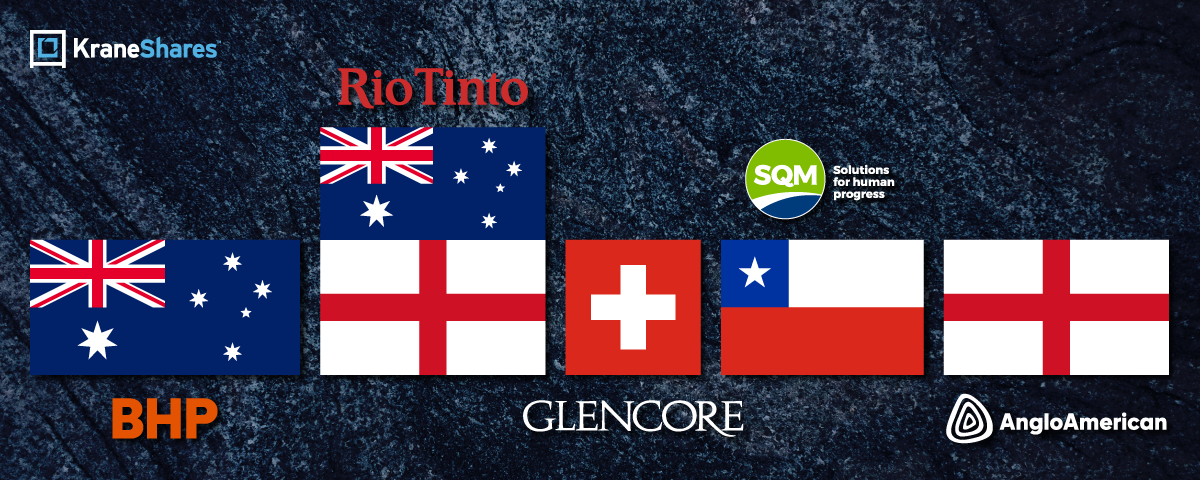
Are Commodity Executives The Best China Economists?
Some investors have been asking whether China’s latest stock market rally has sufficient support from the underlying economy. Official statistics point to overall improvement in the economy’s performance, as China’s gross domestic product (GDP) grew 5.4% in the second quarter of 2025, compared to 5.0% in 2024, while retail sales increased 5.0%.1
We have supplemented the official narrative with testimony from executives from some of the world's largest non-oil commodity-producing and trading firms, who mostly confirm a positive outlook for non-real estate sectors based on commodity demand. Given the nature of their businesses, these executives must rely on a data-driven analysis to inform their views on global commodity markets. However, as stakeholders in these markets, their perspectives may also reflect their firms' strategic interests.
Based on comments from executives at BHP, Rio Tinto, Glencore, SQM, and Anglo American, China’s commodity demand in 2025 remains generally resilient and diverse, characterized by robust growth in infrastructure, manufacturing, and technology-related sectors, despite ongoing weakness in the property sector. Demand for key metals like copper, lithium, and iron ore has been buoyed by policy support, strong exports, record electric vehicle sales, and an aggressive push toward advanced manufacturing and electrification. However, according to Gary Nagle from Glencore, one of the world's largest commodity trading firms, new battery chemistries, such as lithium iron phosphate (LFP), tempered growth in cobalt consumption, which indicates that shifting consumer preferences in China can still have significant impacts on global commodity markets. Ricardo Ramos from Chilean mining giant SQM also confirmed China's increasing preference for lithium for batteries over those that use cobalt. He also projected global lithium demand to increase by 17% in 2025 compared to 2024, mostly attributing this growth to electric vehicle sales in China.
These executives suggest the country is likely to remain a pivotal force in global commodity markets, particularly for metals and materials central to electrification, industrial upgrading, and technology deployment. Anglo American, a large British multinational commodity firm, reports that China represented 45% of its total group revenue in the first half of 2025, and it does not expect that level to decline anytime soon.
The strong commodity demand from China’s economy experienced by commodity-producing and trading firms indicates that China’s economy is strengthening. Investors may want to look to the KraneShares Bosera MSCI China A 50 Connect Index ETF (Ticker: KBA) to gain exposure. KBA focuses on the largest, based on free-float market cap, and most liquid* stocks in China’s onshore (A share) stock market, which is comprised of stocks listed on the Shanghai and Shenzhen stock exchanges. The portfolio has a wide sector distribution, allowing investors to capitalize on potentially rising tides in many sectors. As with any investment, KBA involves risks, including market volatility and regulatory uncertainty in China, that should be weighed alongside potential opportunities.
Quotes2 From Non-Oil Commodity Executives:
BHP Group
Mike Henry, CEO
“In the first half of this year, China exceeded economic growth expectations, with strong export growth. We also saw robust domestic commodity demand from a variety of sectors, including infrastructure and electrification, even as demand from the property sector remained subdued.”
“China’s economic growth is expected to remain resilient, even as the pace moderates slightly in the second half as the boost from ‘pulled forward’ exports unwinds, and new tariffs take effect. That said, it has many policy levers to support its domestic economy, and its exports are likely to remain resilient due to its significant cost competitiveness.”
Rio Tinto
Jakob Stausholm, CEO, & Peter Cunningham, CFO
Copper: “China experienced strong refined copper consumption growth in H1 2025, driven by (1) trade in policies which have stimulated domestic demand for electric vehicles (EV) and consumer durables, (2) the push towards advanced manufacturing (copper-intensive), and (3) front-loading of end-goods exports.”
Aluminum: “The apparent demand for aluminum was firmer in the first half compared to market expectations, which were mainly driven by China.”
Lithium: “Lithium demand continues to be solid in the first half of 2025, with electric vehicle sales up +29% year-over-year, mainly driven by China. About 60% of lithium demand is attributable to batteries in electric vehicles in the first half of 2025.”
Iron Ore: “With strong demand, total iron ore sales in China at our portside business were 16.3 million tonnes, of which 94% were either screened or blended in Chinese ports.”
Glencore
Gary Nagle, CEO
Copper Concentrates: “Industrial demand remained robust during the reporting period, particularly in China, supported by the energy transition sector and related infrastructure investment, as well as fiscal stimulus measures, contributing to a reduction of visible copper inventories following the seasonal build in Q1 2025.”
Cobalt: “From a demand perspective, electric vehicle sales increased again in the first half of 2025, with China continuing to lead. However, a shift in battery chemistries, including increased adoption of cobalt-free chemistries such as LFP, particularly in China, has tempered cobalt demand.”
Zinc: “…Zinc concentrate imports into China were up about 48% in H1 2025.” …As to refined zinc demand, China benefited from front-loading activity in manufacturing and exports, ahead of the anticipated US-China tariff escalation and pockets of strong demand in India and Southeast Asia.”
Iron Ore: “Iron ore demand initially benefitted from the US tariff discussions, which induced some front-loading of Chinese steel production and exports. While Chinese steel production over the first half of 2025 was higher than expected, direct steel exports remained well above expected levels, as the January to May period in 2025 represented an increase of +16% over the same period last year, ensuring that steel margins remained at reasonable levels… …However, prospects for better-than-expected Chinese macroeconomic or government policy support, particularly measures targeting the property sector, could mitigate the consensus view.”
Nickel Market: “China’s stainless-steel industry, a key consumer of nickel demand, front-loaded purchases into the first quarter of 2025. Buying activity reduced significantly in Q2. With steel mills’ margins now under pressure from lower export prices, the netback to Nickel Pig Iron (NPI) is also lower. We estimate that a significant portion of the low-cost NPI industry is now loss-making.”
Ferro-Alloys Market: “Global ferrochrome production declined in the first half of 2025, as smelting conversion margins fell to historic lows, pressured by the ramp-up of low-cost capacity in China. South Africa saw the most pronounced ferrochrome production cuts, with production down -26% year-over-year. Chrome ore prices increased in the first half of 2025, supported by strong demand from Chinese smelters and supply challenges in South Africa.”
Aluminum: “The more recent slowdown of Chinese output underpinned the modest price recovery over the course of the second quarter, while Alumina (aluminum oxide) was among the hardest hit markets during the period…before rebounding on supply cuts in China to reach $350 to $380 per ton by mid-June… The decline in Q1 was driven by supply growth in India and Indonesia, with record Chinese exports and the return to full production of various refineries impacted by outages in 2024.”
SQM
Ricardo Ramos, CEO
"We continue to see strong lithium demand growth across most markets, particularly in China, supported by the growing adoption of LFP battery technology. Despite this, we saw lower prices in May and June this year. Over the past few weeks, we have seen a change in the market dynamic, with prices increasing from what we observed during the second quarter of this year."
Anglo American
Duncan Graham Wanblad, CEO
“Chinese refined copper demand has remained robust, despite evolving US trade policies, while longer-term copper prices are expected to remain well-supported by continued electrification and energy transition infrastructure investment.”
*While the Fund seeks exposure to the largest and most liquid A-share stocks in China, investors should be aware that liquidity may deteriorate during periods of market stress, regulatory disruption, or trading halts. These conditions may impact the Fund’s ability to transact efficiently and could affect performance.
For KBA standard performance, top 10 holdings, risks, and other fund information, please click here.
Citations:
- Data from the National Bureau of Statistics of China as of 6/30/2025.
- Quotes sourced from second quarter earnings reports.
Definitions:
Gross Domestic Product (GDP): The total value of all goods and services produced within a country over a certain time period.

















